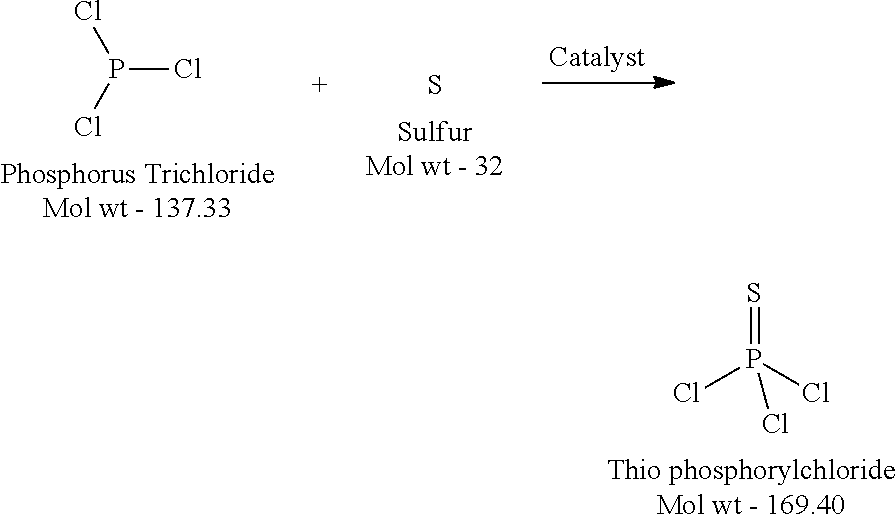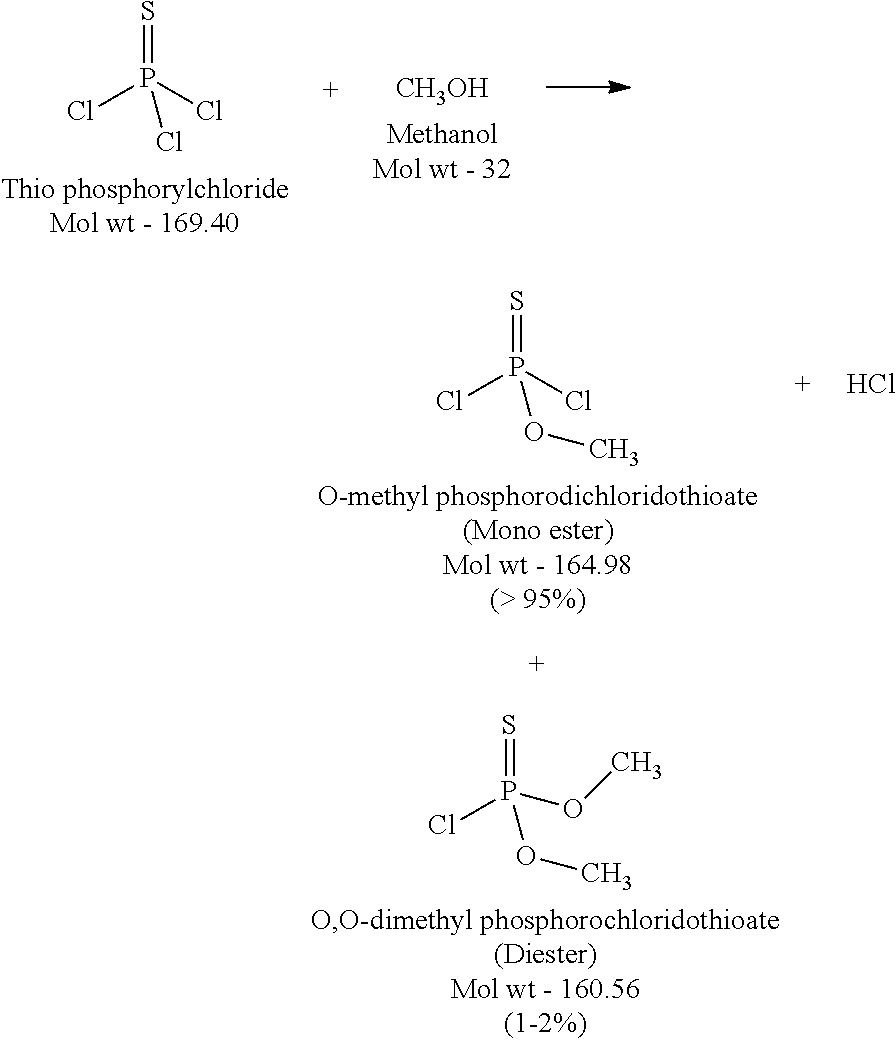Process for preparation of o, o-dimehyl phosphoramidothioate and n-(methoxy-methylsulfanylphosphoryl) acetamide
a technology of odimehyl phosphoramidothioate and n-methylsulfanyl phosphoryl, which is applied in the field of insecticide preparation, can solve the problems of affecting the health of insects, affecting the survival of insects, and affecting the health of people, pets, etc., and achieves the effect of reducing the risk of insecticide us
- Summary
- Abstract
- Description
- Claims
- Application Information
AI Technical Summary
Benefits of technology
Problems solved by technology
Method used
Image
Examples
example 1
[0028]Step 1: Thiolation (Conversion of PCl3 to PSCl3)
[0029]In a multipurpose glass lined reactor of suitable size, molten sulfur (120° C.) is charged (see Table 1) under nitrogen blanket (For the lst batch (Recycle-0), Sulfur is charged 40% excess with respect to PCl3 to ensure proper conversion and reflux temperature). From the metering tank, phosphorus trichloride is added under working condensers and reflux valves open to ensure reflux back of vaporized PCl3. The required quantity (see Table 1) of MEP (methyl ethyl pyridine) is added to the above reaction mixture and the reaction mass is started to be heated. (MEP Catalyst is added only for 1st and 2nd batches, while in subsequent batches it gets carried / recycles via the “HEEL”). Agitator and jacket heating (via high pressure steam) of the reactor is started. The temperature of the reaction mass is raised from initial reflux of 80° C. to 130° C. from 1 to 2 hours. The reaction mass is cooked at 130° C. for another 2 to 3 hours m...
example 2
[0030]Step 2: O-methyl Phosphorodichloridothioate (Methanolysis of PSCl3)
[0031]In a glass lined reactor of suitable size with external heat exchanger & circulatory pump, pre-cooled Thiophosphoryl chloride (PSCl3 99.5% pure) is charged 40% of the total batch requirement & maintained at the same temperature in the reactor. The bottom valve of the reactor is switched on and PSCl3 is looped back to the reactor via an external heat exchanger. Once the circulation is stabilized, pre-cooled methanol (4 molar ratio; 0-5° C.) is added into a circulatory pump inlet line at the rate so as to complete its addition in 3 hours. The remaining quantity of PSCl3 (60%, 0-5° C.) is also added in parallel to methanol, however, it is added via a top liquid addition port into the reactor. Post completion of addition, reaction mass is maintained at 0-10° C. under agitation for another 2 to 3 hours. Reaction mass is analyzed for completion of reaction (PSCl3 less than 0.5%; Mono-ester greater than 95%; Die...
example 3
[0032]Step 3: O,O-dimethyl Phosphorochloridothioate (Diester E-118 formation)
[0033]O-Methyl Phosphorodichloridothioate is charged to a reactor and diluted with CH2Cl2 (3 liters per kilogram (L / kg)). The batch is stirred and the temperature is adjusted to −5 to 5° C. “Methyl lye” (1.1 equivalent) is added to the batch over 2-3 hours maintaining the temperature at −5 to 5° C. “Methyl lye” is prepared by reaction of pre-chilled (0-5° C.) methanol (1.1 equivalent) with aqueous sodium hydroxide (1.1 equivalent) under an inert atmosphere. Commercial “methyl lye” may also be used. Stirring is continued at −5 to 5° C. for 1 hour then analyzed for reaction completion by gas chromatography (GC). The reaction is deemed complete when the relative mono-ester concentration is less than 0.5%. Stirring is stopped and the phases are separated. O,O-dimethyl Phosphorochloridothioate (E-118, Diester) is isolated as a solution in CH2Cl2 in 85% to 88% yield and 94% to 95% purity (GC analysis). E-118 must...
PUM
 Login to View More
Login to View More Abstract
Description
Claims
Application Information
 Login to View More
Login to View More - R&D
- Intellectual Property
- Life Sciences
- Materials
- Tech Scout
- Unparalleled Data Quality
- Higher Quality Content
- 60% Fewer Hallucinations
Browse by: Latest US Patents, China's latest patents, Technical Efficacy Thesaurus, Application Domain, Technology Topic, Popular Technical Reports.
© 2025 PatSnap. All rights reserved.Legal|Privacy policy|Modern Slavery Act Transparency Statement|Sitemap|About US| Contact US: help@patsnap.com



